GLBenchmark 2.5 Performance on iOS and Android Devices
by Anand Lal Shimpi & Brian Klug on July 31, 2012 8:00 PM EST- Posted in
- Smartphones
- GLBenchmark
- Mobile
- Tablets
- SoCs
Earlier today we published our first results using GLBenchmark 2.5, the long awaited update to one of our most frequently used mobile GPU benchmarks. As a recap, here's a quick introduction to the new benchmark:
GLBenchmark 2.5.0 primarily addresses a few shortcomings from the previous version of the Egypt test, primarily by moving to a more challenging version of Egypt. The new game test is named Egypt HD, and moves to a much more complex scene while keeping roughly the same test animation. Geometry count has increased, texture resolution has increased, there's a new water shader, more reflections, and more shadowing. In addition, the offscreen test has now moved to a default resolution of 1080p instead of the previous 720p, for a more challenging workload. This offscreen resolution is now customizable, but we'll be running 1080p for ease of comparison. In addition, the "classic" Egypt test is also a part of GLBenchmark 2.5.0 for those wishing to compare to 2.1.5. In addition, the triangle and fill subtests also stay around for a lower level look at OpenGL ES 2.0 performance. It should go without saying, but GLBenchmark 2.5 is still an OpenGL ES 2.0 test.
In our first article we ran GLBenchmark 2.5 on devices based on Samsung's Exynos dual and quad SoCs, Qualcomm's Snapdragon S4, NVIDIA's Tegra 2/3 and TI's OMAP 4. We had problems getting older devices to run, which is why we only had the abridged set of starting data on Android. In addition, GLBenchmark 2.5 for Android only supports Android 3.x and up.
GLBenchmark 2.5 is already available in the Google Play store, however the iOS version isn't quite ready for public release. Thankfully we've been able to get our hands on the iOS version and now have results for the new iPad, iPad 2 as well as the iPhone 4S. Just as before we've split results into tablet and smartphone performance. Let's tackle the tablets first.
Tablet Performance in GLBenchmark 2.5
Apple's A5X SoC is a beast as we found in our investigation of the chip earlier this year. The SoC marries a quad-core PowerVR SGX 543 with a quad-channel memory controller, good for up to 12.8GB/s of memory bandwidth. The combination of the two is a GPU that significantly outperforms anything else on the market today.
The A5X's dominance extends to GLBenchmark 2.5. Low level performance ranges from 33% faster than NVIDIA's Tegra 3 on the low end to over 3x the performance at the high end. Even Apple's A5 found in the iPad 2 tends to be the second fastest SoC in these tests.
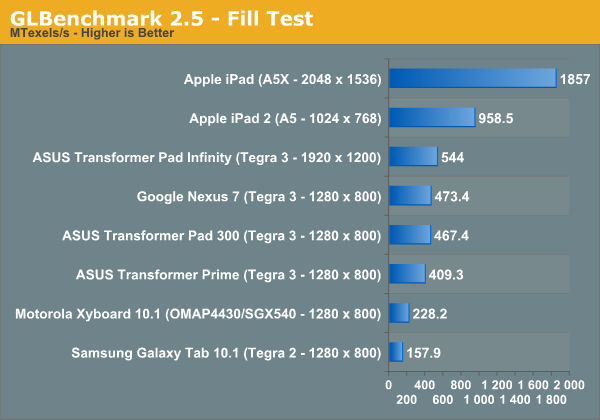
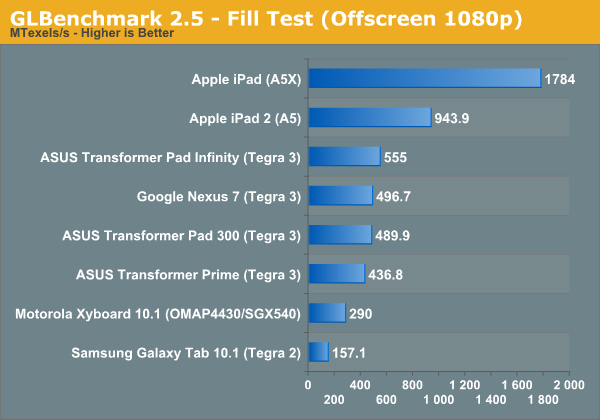
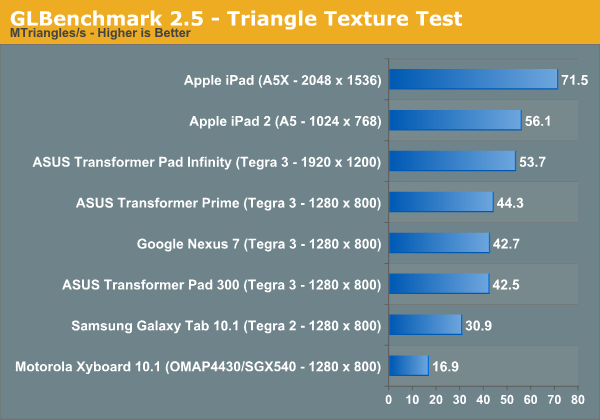
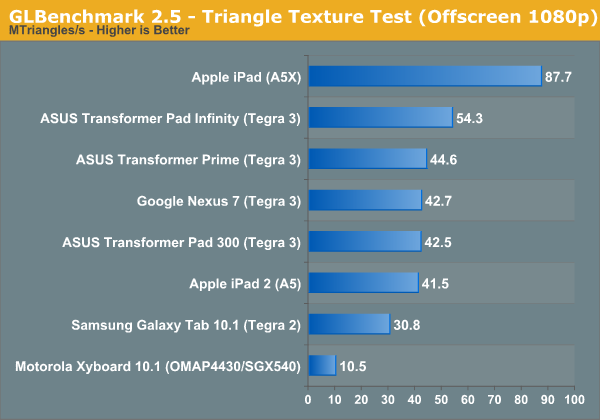
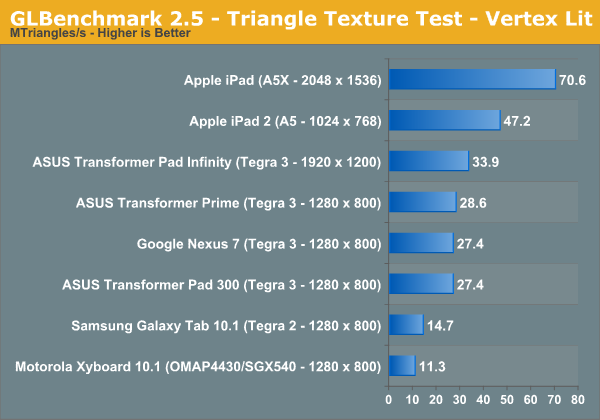
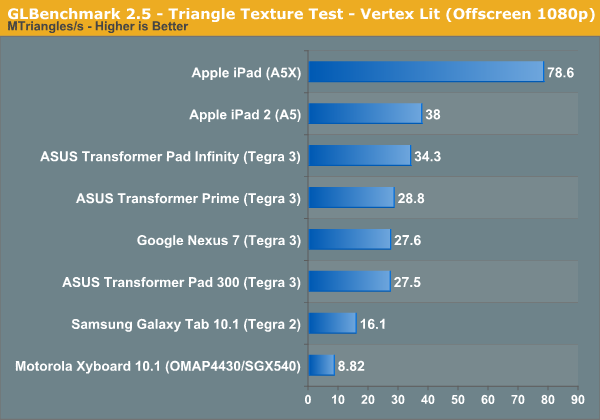
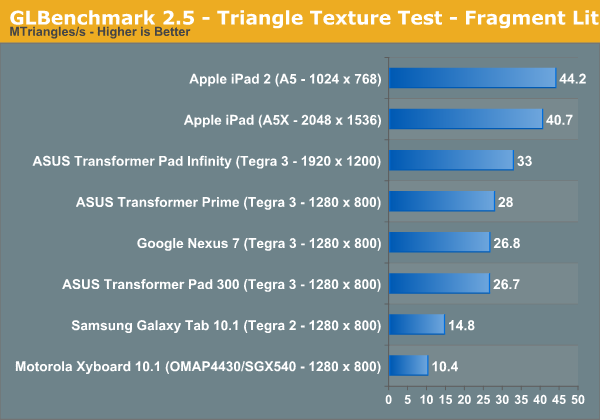
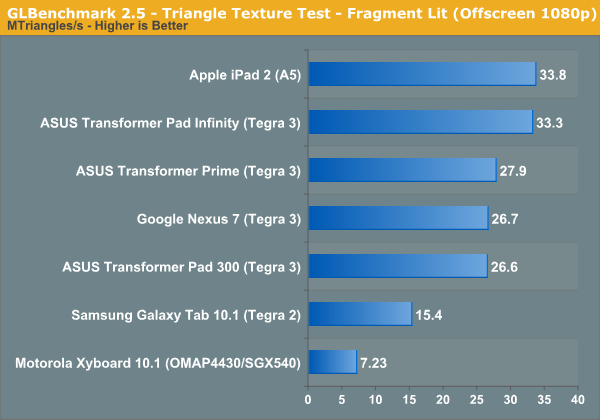
Egypt HD continues to be unrelentless in its punishment of mobile SoCs. The A5X is able to just keep up with the A5 thanks to the new iPad's significantly higher native resolution. Even the A5 running at 1024 x 768 can only muster 22 fps in the new Egypt HD test. It's going to take another generation of mobile GPUs to really sustain playable frame rates here.
The offscreen test runs without vsync enabled and at a standard 1080p resolution for all devices. In the case of the new iPad this works out to be a significantly lighter workload, which is responsible for the 20% higher frame rate. Even at 1080p though, the A5X isn't enough to sustain 30 fps.

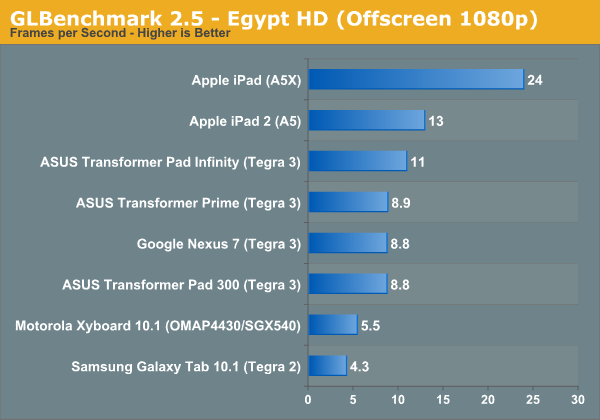
The classic Egypt benchmark once again gives us a good indication of present day gaming performance, which for the most part is fine on any of the latest SoCs.
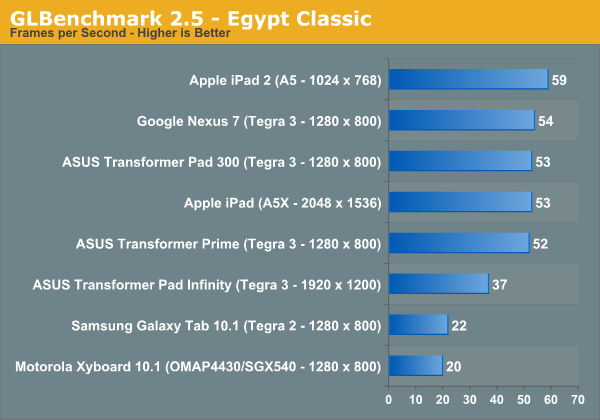
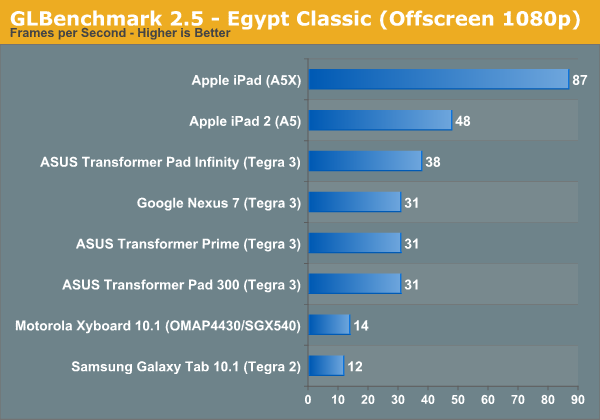


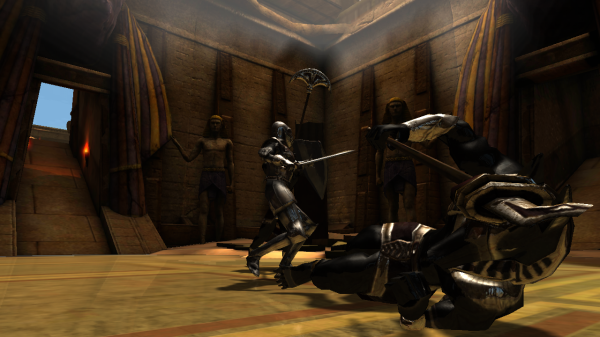














57 Comments
View All Comments
tipoo - Wednesday, August 1, 2012 - link
"most important performance category" isn't objective. Some would say CPU performance is more important.Mike1111 - Tuesday, July 31, 2012 - link
"The pressure is on for Apple to deliver something between the A5 and A5X in the next generation iPhone this fall."Well, Apple just needs to clock the 32nm A5 in the iPhone 50% higher (to 1.2GHz, just 20% higher then the A5 in the newer iPad 2) to be consistently on top again. But 100% (to 1.6GHz) would be better. Too bad the really big jump in performance will probably have to wait until 2013 with a dual/quad-core big.LITTLE and Rogue.
ltcommanderdata - Tuesday, July 31, 2012 - link
50% clock speed bump may be good enough against current SoC at the time of launch, but with Adreno 320, Tegra 3+ T37, Wayne, and Mali-T604 around the corner, Apple's going to need to do better than that to hold the GPU performance crown into 2013.dagamer34 - Wednesday, August 1, 2012 - link
A 50% jump in CPU and GPU performance is no slouch, remember that the iPad 3 had zero improvements to the CPU and because of the Retina display, the 543MP4 just barely keeps up with the 2048x1536 resolution increase in anything that heavily relies on the GPU.lilmoe - Wednesday, August 1, 2012 - link
big.LITTLE will come with more of an advantage to Samsung's Exynos than any other SoC ATM. The sole reason being that Exynos 5 (and beyond) is probably the only (announced) chip equipped with the Mali-t604 (and t658) GPU. Other than the advanced GPU features and the unified shaders, ARM's Midgard architecture was developed and fully optimized for load balancing, FPU offloading, and interconnect coherency, some of the major architectural selling points of big.LITTLE (other than the obvious load balancing of low power (cortex a7) and high performance (cortex a15) CPUs).PowerVR's offerings are great, but they're just not as compatible.
DracoNB - Wednesday, August 1, 2012 - link
Anyone else notice some strange stuff going on with the offscreen vs "native" resolutions in the tests?For example:
"new" iPad @ 2048x1536 gets 1857 and offscreen at a lower 1080p (almost 50% less pixels) gets a LOWER score of 1784?
How does that work unless its not really running @ 2048x1536 but is being upscaled?
The Nexus 7 has a similar issue, where it gets a better score when going offscreen to a higher resolution.
amdwilliam1985 - Wednesday, August 1, 2012 - link
Great catch.I wouldn't be surprise an unethical company such as Apple doing unethical stuff.
darkcrayon - Wednesday, August 1, 2012 - link
Even though he said the Nexus 7 had the same "problem"?Nevermind, I see you're the same one trolling up the rest of the comment section with gibberish.
UltraTech79 - Wednesday, August 8, 2012 - link
Oh god, get the fuck over yourself. No every benchmark issue is somehow some evil corporate conspiracy. Get your head checked. People like you, doesn't matter what brand they love/hate, have metal issues. Come back to realityjadawgis732 - Wednesday, August 1, 2012 - link
Unrelentless is not a word, it's just terrible English.